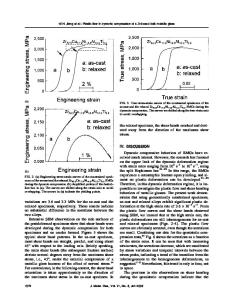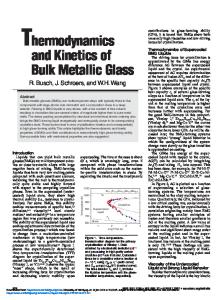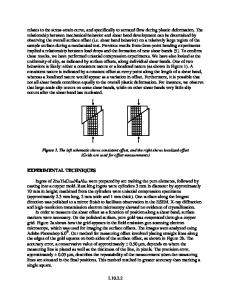Multiaxial deformation characteristic of a Zr-based bulk metallic glass: Variations of the plastic constraint factor und
- PDF / 557,060 Bytes
- 7 Pages / 585 x 783 pts Page_size
- 100 Downloads / 819 Views
Ju-Young Kim Department of Materials Science and Engineering, Seoul National University, Seoul 151-744, Korea
Un-Bong Baek and Seung-Hoon Nahm Division of Metrology for Quality Life, Korea Research Institute of Standards and Science, Daejeon 305-340, Korea (Received 19 March 2007; accepted 25 June 2007)
Multiaxial deformation of Zr55Al10Ni5Cu30 metallic glass was investigated by instrumented indentation tests with a spherical indenter. Contrary to the elastic–rigid-plastic behavior of bulk metallic glasses (BMGs), indentation pressure showed a significant increase with increasing indentation strain, and it was ascribed to a rapid transition of the plastic constraint factor (PCF). However, it was impossible to measure the PCF values from the indentation pressures in the Zr-based BMG because information on uniaxial flow stress was insufficient due to the limited flow strain of 2.2%. Here we developed a PCF assessment method using a relative residual depth hf /hmax, which was experimentally confirmed by adopting it to spherical indentations of a steel sample having well-known flow properties. Flow properties of the BMG were calculated using the new PCF assessment method, and the effects of the materials pileup and low strain indentations on PCF and flow properties were discussed.
I. INTRODUCTION
Although bulk metallic glasses (BMGs) have good mechanical properties such as high yield strength, wear resistance, and wide elastic response, catastrophic fracture occurs after severe strain localization at a few shear bands corresponding to tensile straining1 because they have no feasible plastic deformation mechanism such as dislocation slip in ductile metals. However, the brittle fracture mode can be relaxed by increasing geometrical constraint of specimen or by changing loading modes to compression,2–4 bending,5 and indentation.6–9 Numerous indentation works6,7,9–15 have focused on determining the yield criteria and plastic constitutive equations based on the significant contact deformations. The unique deformation phenomena of BMGs are ascribed to combination effects of hydrostatic and shear stresses on yielding, which has been explained by the Mohr– Coulomb3,6,7,9,10 and Drucker–Prager yield criteria.11–14 While a geometrically similar sharp indenter produces
a)
Address all correspondence to this author. e-mail: [email protected] DOI: 10.1557/JMR.2007.0359 J. Mater. Res., Vol. 22, No. 10, Oct 2007
http://journals.cambridge.org
Downloaded: 02 Feb 2015
a constant strain independent of the applied load, a spherical indenter forms strain increments with increasing indentation depths, and thereby it is used to study the mechanical properties as a function of the indentation strain; a plastic flow curve equivalent to the true stress– strain relationship from uniaxial compression or tension test can be derived if the flow stress is determined from the indentation pressure at each indentation strain level according to previous spherical indentation studies on ductile metals.16–20 Here a ratio of the indentation pressur
Data Loading...











